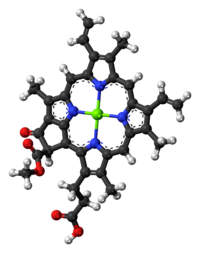Chlorophyll c
 |
|
 |
|
| Names | |
|---|---|
|
IUPAC name
[(2E)-3-[14-Ethyl-21-(methoxycarbonyl)-4,8,13,18-tetramethyl-20-oxo-9-vinyl-3,4-didehydro-3-phorbinyl-κ2N23,N25]acrylato(2-)]magnesium
|
|
| Identifiers | |
| ChemSpider | |
|
PubChem CID
|
|
| Properties | |
| C35H30MgN4O5 | |
| Molar mass | 610.95 g·mol−1 |
|
Except where otherwise noted, data are given for materials in their standard state (at 25 °C [77 °F], 100 kPa).
|
|
|
|
|
| Infobox references | |
 |
|
 |
|
| Names | |
|---|---|
|
IUPAC name
[(2E)-3-[21-(Methoxycarbonyl)-4,8,13,18-tetramethyl-20-oxo-9,14-divinyl-3,4-didehydro-3-phorbinyl-κ2N23,N25]acrylato(2-)]magnesium
|
|
| Identifiers | |
| ChemSpider | |
|
PubChem CID
|
|
| Properties | |
| C35H28MgN4O5 | |
| Molar mass | 608.94 g·mol−1 |
|
Except where otherwise noted, data are given for materials in their standard state (at 25 °C [77 °F], 100 kPa).
|
|
|
|
|
| Infobox references | |
| Identifiers | |
|---|---|
| Properties | |
| C36H28MgN4O7 | |
| Molar mass | 652.95 g·mol−1 |
|
Except where otherwise noted, data are given for materials in their standard state (at 25 °C [77 °F], 100 kPa).
|
|
| Infobox references | |
Chlorophyll c is a form of chlorophyll found in certain marine algae, including the photosynthetic Chromista (e.g. diatoms, brown algae) and dinoflagellates.
It has a blue-greenish color and is an accessory pigment, particularly significant in its absorption of light in the 447-452 nm wavelength region, Like chlorophyll a and chlorophyll b, it helps the organism gather light and passes a quanta of excitation energy through the light harvesting antennae to the photosynthetic reaction centre. Chlorophyll c is unusual because it has a porphyrin ring structure and does not have an isoprenoid tail or a reduced ring D, features typical of the other chlorophylls commonly found in algae and plants.
Chlorophyll c can be further divided into chlorophyll c1, chlorophyll c2 and chlorophyll c3, plus at least 8 other more-recently-found subtypes.
Chlorophyll c1 is a common form of chlorophyll c. It differs from chlorophyll c2 in its C8 group, having an ethyl group instead of vinyl group (C-C single bond instead of C=C double bond). Its absorption maxima are around 444, 577, 626 nm and 447, 579, 629 nm in diethyl ether and acetone respectively.
Chlorophyll c2 is the most common form of chlorophyll c. Its absorption maxima are around 447, 580, 627 nm and 450, 581, 629 nm in diethyl ether and acetone respectively.
Chlorophyll c3 is a form of chlorophyll c found in microalga Emiliania huxleyi, identified in 1989. Its absorption maxima are around 452, 585, 625 nm and 452, 585, 627 nm in diethyl ether and acetone respectively.
...
Wikipedia
